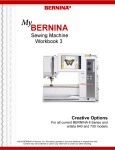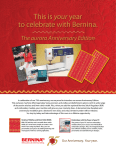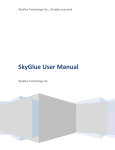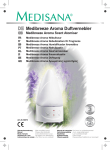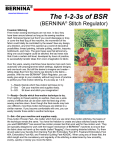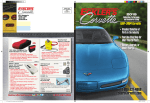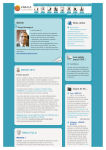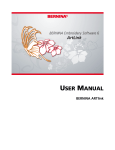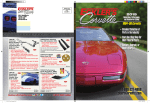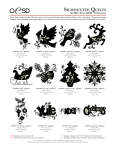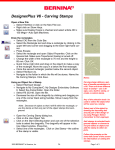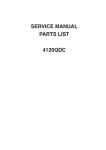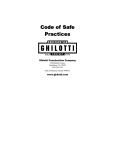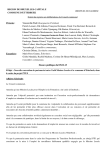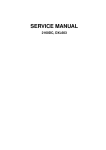Download What`s Inside? - Amazon Web Services
Transcript
E M B RO I D E RY HOLIDAY SEWING What’s Inside? • BERNINA® News • Hearts & Holly Dress • Buttonhole Banter • Hiker’s Hydration Pack • Baby Ruffles • The Quiltmaker’s Gift Challenge • Festival of Quilts • BERNINA® Fashion: Sewing the Season • Stitch Recipe • Software Skill Builders: The Forgotten Resource • Professional Profile Pages 4-6 PORTRAIT of the ARTIST “I want my pieces to make you smile... with her when you look at them.” BERNINA Barbara Randle – fiber artist,teacher “I start with happy colors and then throw in the unexpected.” “I’ll tell students, ‘Pick out a fabric you really love and then build on it. Add colors that turn you on, add fuzzy things, beads, tassels. If you get to a point where you’re stumped, imagine what you think needs to go there and then do the opposite.’ It’s a fun way to stretch the imagination.” “If you want to get this wild and crazy, you need a Bernina.” “I own five Bernina machines now, but my favorite is the 180E. Between all the decorative stitches and the 9mm stitch width, I can get my embellishments so incredibly bold and beautiful. I love the 16-directional sewing as well. It’s definitely the most fun you can have with a sewing machine.” ©2002 Bernina of America • Visit www.berninausa.com for a dealer near you. December 2002 H W O We Are... JO LEICHTE The Quiltmaker’s Gift Challenge Currently in a garment and small quilt phase, Jo is constantly on the lookout for quick, simple projects to share with beginning seamsters. As Editor for BERNINA® of America, Jo is instrumental in the production of Through the Needle. NANCY BEDNAR Buttonhole Banter One of BERNINA®’s freelance serging experts, Nancy also creates exquisite stitched garments, quilts, and crafts. She is also co-author of The Encyclopedia of Sewing Machine Techniques, as well as author of several other books and contributor to many sewing publications. SUSAN FEARS BERNINA® Fashion Susan enjoys all types of sewing, especially garment making. She got hooked on quilting while making a quilted jacket, and now enjoys quilts throughout her home. She finds inspiration everywhere, especially through her travels as an Educator for BERNINA® of America. GAYLE HILLERT BERNINA® News An avid sewer since she was a young girl, Gayle has managed to combine her vocation and her avocation. As Vice President of Education for BERNINA® of America, Inc. she is responsible for training, education and testing functions relating to all BERNINA® products. DONNA HODGES LITT America from the Ashes In addition to creating "healing quilts" such as “America from the Ashes”, Donna adopts orphan quilt blocks that she finds at flea markets and garage sales. She then lovingly fashions them into quilts and begins a “history” label for each one. JENNIFER GIGAS Hiker’s Hydration Pack Jennifer, an Education Consultant for BERNINA® of America, combines serging, sewing, and embroidery in many of her up-dated interpretations of favorite patterns, many of which incorporate decorative serger techniques in unexpected places. DEBRA BOHN Stitch Recipe Debra teaches software, quilting, garment construction, heirloom and machine embroidery classes. Her specialites are the artista software and embroidery systems. She currently travels to many different dealerships to teach classes, one of which is her popular “Tips and Tricks for Successful Machine Embroidery” class. SUSAN BECK Houston Quilt Festival With a background in Art and Home Economics, Susan is interested in all types of sewing and crafts and has written several sewing books. She loves to be creative on paper as well as in fabric and is the Director of Web and Education Communications for BERNINA® of America, Inc. MARLIS BENNETT Hearts & Holly Dress Marlis creates unique interpretations of classic and heirloom sewn garments, incorporating decorative stitching techniques and embroidery in imaginative projects. As an Education Consultant for BERNINA® of America, Marlis puts her own stamp of creativity on machine sewn projects. KAY LYNCH Baby Ruffles As a Card Production Assistant at OESD, Inc., Kay’s job is to assist in the development of designs and embroidery cards for BERNINA® and OESD, and to create projects using the embroidery designs. She has a BS degree in Home Economics Education from Oklahoma State University. She has taught serger classes for the past 12 years at Canadian Valley Technology Center in El Reno, Oklahoma and at BERNINA® of OKC South. MARLENE BRYANT Software Skill Builders Finding time to sew recently, Marlene has been creating whimsical and eclectic machine-embroidered stitchery using the artista Designer software. As an Education Consultant for BERNINA® of America, Marlene focuses much of her time on teaching dealers how to use the artista embroidery software. 1 Through the Needle America from the Ashes, Page 4 Hiker’s Hydration Pack, Page 12 The Quiltmaker’s Gift Challenge, Page 18 BERNINA® FASHION: Get to know the excellent staff and stitch- Who needs more than one buttonhole SEWING THE SEASON WHO WE ARE... BUTTONHOLE BANTER ers that contribute tips, project ideas and style? You do! “Mystery” buttonholes explained, including keyhole, round, stories to Through the Needle. stretch, and straight stitch. Page 1 Pages 10-11 BERNINA® NEWS “Healing” quilts and handmade gifts are just a few of the many ways in which stitchers express their creativity and share their special talents. Page 3 Find out what’s new for Winter 2003, and learn how to incorporate these trends – ruffles, plaids, and more – into you sewing projects. Page 24-25 HIKER’S HYDRATION PACK Something for the hiker, mountainclimber, and other outdoor enthusiasts. A compact carrying pouch for a water reservoir keeps fresh water nearby and easily accessible. Page 12-13 STITCH RECIPE This beautiful stitch combination, reminiscent of delicate insertion lace, is perfectly-suited for blouses, pillow borders, or French heirloom sewing. Page 26 BABY RUFFLES Transform a plain “onesie” into a darling SOFTWARE SKILL BUILDERS: THE FORGOTTEN RESOURCE The story of one woman’s effort to come ruffled outfit for a special little girl. This often neglected resource is right at Pages 16-17 to terms with the events of September 11, your fingertips, providing easy access to 2001 by creating a memorial to those who stitch patterns, fancy fill illustrations, and lost their lives that day. THE QUILTMAKER’S GIFT CHALLENGE more. Pages 4-6 Award-winning quilts inspired by the Page 27 beautifully illustrated book about a generous quiltmaker and a selfish king. Pages 18-20 PROFESSIONAL PROFILE Get to know Jennifer Sheriff, Product HEARTS & HOLLY DRESS Development Director for Oklahoma A precious dress for a little girl, embel- FESTIVAL OF QUILTS lished with embroidery, off-the-edge News from the fall Quilt Festival, includ- Embroidery Supply and Design, who stitching, and decorative double needle ing the winner of the second Bernina® quilts and creates costumes for Renaissance Faires in her spare time. pintucks. Fashion Show, “Masquerade.” Pages 22-23 Page 28 Pages 7-9 AMERICA FROM THE ASHES 2 December 2002 BY GAYLE HILLERT e all have varying reasons for sitting in front of sewing, W serging and embroidery machines. The very act of creating can answer needs we have as human beings. September 11, 2001 was an unbelievably frightening experience for the entire world. Different segments of society have worked through the ramifications of September 11 in different ways. Many sewers began the healing process by putting fabric and threads together to speak to what they felt during the horror of that day and the days and weeks thereafter. The wonderful inspirational quilt on the cover of this issue – “America from the Ashes” - of Through the Needle is one woman’s way of remembering September 11. Studies have shown that sewing alleviates stress. Many professionals are turning to creating with sewing systems as a way to supplement and enrich their business lives. Quilters have known for generations that the rhythm and routine of quilting offers soothing and healing properties. Women of years past met together over a quilting frame to sew patches of fabrics together as well as share their isolation, receive advice on raising children, healing with herbs and natural ingredients and patching their own lives together with others of kindred spirits. Today, women sew for personal fulfillment rather than out of necessity. Whether stitching quilts for loved ones, designing garments which express a unique fashion sense, or constructing items to embellish our homes, we sew to express our creativity. The wearable art mod- eled at the recent BERNINA® Fashion Show in Houston, “Masquerade,” represents only a sampling of the marvelous ways in which fabric and thread can be used to express concepts and feelings. Another reason for sitting at our sewing systems is to create items for those we love. The gift of giving is never more rewarding than when we have made the gift ourselves. Every issue of Through the Needle offers many items for creating, such as the adorable Hearts & Holly dress for a very special little girl, or the practical Hydration Pack for a favorite hiker or climber, both featured in this issue. Also included are quilts from The Quiltmaker’s Gift challenge sponsored by BERNINA® of America, Quilters’ Resource, Benartex fabrics, and Scholastic books; quilts that were made to be given away, reflecting the spirit of giving exemplified by the generous spirit of the quiltmaker in The Quiltmaker’s Gift. When we give a gift we made with our BERNINA® machines, we often reap the benefits of the reward of giving more than the recipient. There is nothing more fulfilling than planning a project concept from the very beginning, selecting colors, fabrics, threads, sitting and dreaming at our machine, realizing the concept, wrapping the package, and receiving the gratitude and often amazement at our talents from the recipient. Enjoy your creating, reap the benefits of sewing, and have a wonderful holiday. 3 Through the Needle BY DONNA HODGES LITT & JO LEICHTE “September 11, 2001 At 8:45 a.m. EDT a hijacked passenger jet, American Airlines Flight 11 out of Boston, Massachusetts crashes into the north tower of the World Trade Center, tearing a gaping hold in the building and setting it afire. At 9:03 a.m. a second hijacked airliner, United Airlines Flight 175 from Boston, crashes into the south tower of the World Trade Center and explodes. Both buildings are burning. At 9:43 a.m. American Airlines Flight 77 crashes into the Pentagon, sending up a huge plume of smoke. At 10:10 a.m. United Airlines Flight 93, also hijacked, crashes into Somerset County, Pennsylvania. This jet was probably headed for the White House but was brought down by passengers and crew. The last words reportedly said by the passengers were ‘Let’s Roll.’ The death toll from this terrorist attack is expected to be in the tens of thousands. Behind the deadly attacks is bin Laden of the Taliban, in Afghanistan.” “This quilt was made to help me heal from the terror that we all felt after the tragedy that occurred on September 11, 2001. When I started the quilt, I wanted an individual red, white or blue piece of fabric to represent each person that lost their life that day. At first the death tolls were so high...the preliminary numbers estimated more than six thousand victims! As I worked on the quilt, mercifully the numbers dropped...an answer to my prayers. On March 28, 2002, the day I was finishing up the quilt top the death toll stood at 3,063 people; therefore each one of the 3,063 red, white and blue fabric pieces is in memory of one of the victims lost that day. There were 2,830 people killed in the World Trade Center, including the passengers and crew of the two high-jacked planes. The Pentagon had 125 victims on the ground and American flight 77 had 64 passengers. The United flight that went down in Pennsylvania had 44 victims in all. Each one of these people will remain in my thoughts and prayers and surely they will remain in all our hearts forever. Made in loving memory by Donna Hodges Litt, April 2002, Golden, Colorado” - quilt labels on “America from the Ashes” 4 December 2002 I n addition to her “healing quilts,” Donna also collects and documents stray quilt blocks from flea markets and estate sales. “I love old quilts but the prices are always so high. So I started collecting blocks that were started and never finished. I felt they needed a story and a documented history. I put the blocks together as well as I can; they usually become table toppers or runners, or, if I’m lucky enough, a quilt. I try to find out as much as I can about the blocks, and I include the history on a label. I wish I knew the whole stories of these “orphan” blocks, but that’s real rare.” Donna started created the first of her “healing quilts” as an outlet for her feelings during a particularly difficult and emotional time in her life. “I made a quilt for my father when he went to a nursing home. You can only give them so many slippers and robes. He had dementia, so I put things on the quilt that would remind him of the years on the farm and happier times. He loved horses, windmills, sunrises and sunsets, his family and God. Every member of the family helped me by making a block. Being from a small town, the nurses had known him long before he moved into the home, and the quilt gave them something to talk to him about. I’m not sure if it helped him or me more.” “Then I made a few others to help me through tough times. I lost a very good friend, a member of our quilt group, to cancer. Through the last year of her life our group exchanged fabrics; the last fabric I received from her included a note that said “When life gives you scraps, make quilts.” I made a quilt using the fabrics we had exchanged, scanned her note, and made it part of the quilt label. She was such a gentle and kind lady with a very strong faith, so I used the biblical block “Jacob’s Ladder” for the quilt and appliqued flowers on the border. I love that quilt – it gives me a warm and fuzzy feeling each time I see it.” “After my father died in 1996 the quilt I made for him was such a comfort for my mother that I decided to make her a quilt of her own. I made a crazy quilt with lots of flowers, laces and trinkets. Everyone in the family is represented in some way, and the label lists everyone’s birthdays and anniversaries, deaths and adoptions, so Mom will always have them at her fingertips. Plus, every time I go home to North Dakota I secretly add another charm or trinket so that every time she looks at it she’ll find something new.” Also included in this quilt is a favorite verse: Once upon a memory, Someone wiped away a tear, held me close and loved me, thank you, Mother dear. “Then came the terrible events of September 11, 2001. I knew I wanted to make something so my grandkids would have something to mark that awful day. I knew I wanted to include a flag – for America and our freedom, and I wanted each life lost that day to be represented by a piece of fabric.” “The death toll was so high at first. I worked on the quilt until Thanksgiving; then I just had to put it away for a while as it was so depressing. After the New Year I picked it up again, and I a better feeling about it as the death toll had dropped so much. Also, wherever I went, I saw that people that were proud to be Americans and were expressing their patriotism much more than before.” “When the quilt was finally finished and shown in public, many of the people that saw it began sending charms and other items to me, so I’m continually adding to it. I can’t believe what a tremendous response it gets.” Included among the many charms, military bars and jewelry pieces is a watch set at 8:45 a.m., representing the moment when “time stopped” as the first plane crashed into the World Trade Center, and a tiny silver dog to commemorate the animals that went into the wreckage in search of survivors. For more about the America from the Ashes” Quilt visit www.indesigns.stormer.org/donnasheart/ “America from the Ashes” has become a traveling memorial to the events of September 11th. “While making ‘America from the Ashes’ didn’t help me heal, it did help me get my head and heart wrapped around what happened that terrible day. And by showing the quilt and talking about it I know that I have touched a lot of hearts. There are always lots of tears in the audience. While it is easy to go on with life and let the import of these events slowly diminish, it is important that we remember and not let them be pushed aside.” 5 Through the Needle Donna Litt’s “America from the Ashes” is a moving expression of the horror and sadness felt by people all over the world following the events of September 11, 2001. Quilters – as well as artists in other media – have expressed their feelings and recorded events through their creative work for centuries. 6 December 2002 BY MARLIS BENNETT Supplies • BERNINA® artista • BERNINA® artista software • OESD embroidery design #NV194 • Large artista embroidery hoop or Mega Hoop for artista 200 • Second bobbin case for tension manipulation to accommodate Décor thread • Edgestitch Foot #10/10C • Embroidery Foot #15 • Pintuck Foot #31 (5-groove) • Clear Foot #34/34C • Binder Attachment #84, size 2630mm, with Foot #94 • #80/12 Universal needles • #75/11 Embroidery needles • 2.5 Double needle • 50wt Mettler Silk Finish thread–Red • YLI Designer 6 – Red • 60wt Mettler Embroidery/Darning thread to match fabric • Embroidery thread as desired to complete embroidery design • OESD BadgeMaster stabilizer for collar embroidery and collar edging • OESD Lightweight Tear-Away stabilizer • 505 temporary spray adhesive • Fabric marking pen • Ruler • Pattern: Martha Pullen’s “Grandmother’s Hope Chest” – High Yoke (size 18 mos) • Fabric as required by pattern • Entredeux for collar edging and sleeves • Edging lace for sleeve ends • Decorative ribbon for sleeve casings • Optional: Computer scanner 7 Through the Needle Instructions Refer to pattern for detailed sewing instructions. DECORATIVE FEATHER STITCHING Trace the collar pattern behind the text on this page. Cut two front collar pattern pieces and cut two back collar pattern pieces on the fold as noted on the pattern. Sew outside front collar to back collar. Using a fabric market, draw straight lines 11/4” from raw edges and 1” from folded back edges. Attach 2.5mm Double needle to machine. Attach secondary spool holder. Thread Double needles with red Mettler Silk Finish thread. Wind a bobbin with Mettler 60wt embroidery cotton to match fabric; insert into machine. Open the bobbin area door, unreel some of the Designer 6 (red), then thread the end up through the opening in the front of the stitch plate in front of the needle. Select the feather stitch: #332 on the artista, from the quilt stitch menu. Adjust the stitch length to 3.5mm and activate the Security Function or the Double Needle Limitation (select 2mm). Stitch this “corded featherstitch” along the lines drawn on the collar, pivoting at the corners. When pivoting, take care not to pull excess bobbin thread and Designer 6 from under the needle. Should this happen, you will have a loop on the underside of the fabric. HEARTS & HOLLY EMBROIDERY Open the artista software. Open OESD design #NV194. Rescale to fit inside the large artista hoop. Use the Polygon Select tool to select the holly leaves, small hearts, and ribbon on one side of the center heart. Group this selection. Select the leaves, hearts, and ribbon on the opposite side of heart; group together as one object. Select the heart and bow and group them together to form the third element of the design. Switch the groupings on either side of the center heart; rotate into desired positions. Rotate the center heart motif into position. When satisfied with the arrangement, print a template of the altered design. Using the paper template, mark the position of the design on the collar front. T ip: If a com is availa puter scanne r ble to y ou, sca the fr with pin ont collar piec n e tuc it’s pos k stitching. Th sib e the em le to position n broidery design to exac tly to the coll fit ar. Stabilize the embroidery area with two layers of BadgeMaster stabilizer and one layer of lightweight Tear-Away. The BadgeMaster next to the fabric is easy to remove by rinsing, and the Tear-Away will prevent the satin stitches in the small hearts and holly leaves from pulling izers, and tunneling.) Hoop all layers in e stabil Hoop th 05 temporary 5 the large artista embroidery hoop. h it y w tl n y ge spra e, then Embroider design on one layer of adhesiv e collar into th collar. e smooth th in T ip: position ry area e embroid hoop. of the When embroidery is complete, gently remove all traces of the Tear-Away stabilizer. This can be accomplished easily using a pair of tweezers with no risk to the fabric since the BadgeMaster Stabilizer is still in place. When all of the Tear-Away stabilizer is gone, remove the BadgeMaster stabilizer. 8 Sew front collar linings to collar backs. Cut seam allowance from neck edge. Fold collar so that the lining is positioned under the top and all raw edges are together. Sew entredeux around the remaining raw edges of the collar, omitting the neck edge – begin at the left back, sew the left side, then sew to the lower edge of left front, to lower edge of right front, to right side, and finally to right back. Trim all seam allowances from entredeux before beginning the next step. DECORATIVE EDGING On the artista, open an empty memory bank. Enter one scallop stitch #719. Select the 4-direction menu; enter directional zigzag stitch #41. Select direction #16 (straight up); enter two of stitch #41 into the memory. Touch Edit; move the needle position to the third dot from the left for both directional stitches. Change the scallop stitch width to 6mm and the length to 1mm. Close Edit. Store design in memory. Place two layers of BadgeMaster stabilizer under all entredeux edges of the collar. Attach Clear Foot #34/34C. Wind Designer 6 on an empty bobbin and insert into secondary bobbin case, adjusting tension as needed. Thread needle with Mettler Silk Finish cotton thread. Position fabric so that the edge of the entredeux is directly under the left toe and aligned with the inside edge of the left toe. When sewing, only the “V” of the straight stitch scallop should stitch into the fabric. Begin sewing at the back of the collar; sew around entire collar. Knot beginning and ending threads and seal with seam sealant. Trim threads. Remove excess stabilizer. Embroider one panel (6” wide by width of skirt piece) of contrast fabric with the rescaled embroidery design. Use two layers of BadgeMaster backed with one layer of Tear Away stabilizer for each design. To get the designs to come out so that exactly six designs fit in the skirt area, measure the finished width of the skirt and divide by six. This number is the actual size each embroidery motif must be for exactly six pattern repeats. Hint: The easiest way to align a row of embroidered designs quickly and easily is to create your own reference point at the beginning of each design, at the point where the motifs meet - in this case, the foremost point of the first holly leaf. To create a reference point: Open design in an embroidery software with digitizing capabilities. Use the Zoom tool to zoom in on the area where the reference point is needed. Activate the Outline option and the Open Curve tool. Select a color not contained in the design. Left click one time on the desired location. Press Enter. Open the Color Film option in the Arrange menu. Move the reference point to the beginning position. December 2002 ON THE EMBROIDERY MACHINE For perfect positioning, embroider the first design where desired. Re-hoop for the second design. Go to Layout and select the Needle Start option. Position design so that the needle is in the exact position needed to align the next embroidery motif. In the embroidery screen, forward to color 2 and stitching. With this technique, you can set your personal reference points in any desired location for any design. Once embroidery is completed on skirt band, sew corded featherstitch pintucks (as on collar) 3/4” from embroidery. Sew one row on each side, backing the embroidered panel with another piece of fabric if using white for the band. Sew entredeux to top and bottom edges of embroidered panel, 1/4” from corded pintucks. Sew band into a circle matching embroidery, pintucks, and entredeux. Once dress is completed, insert into skirt band 3” above folded hem using your favorite entredeux-tofabric method (see any heirloom sewing book, such BERNINA®’s Heirloom Beginnings by Gayle Hillert), removing the amount of skirt fabric replaced by the width of the band. SLEEVE FINISH Hint: Use a Double needle the same width as the ribbon to stitch both sides at the same time. Thread elastic between ribbon and sleeve. Cut elastic to length recommended in pattern. Stitch ends of ribbon and elastic together. Finish sleeve as described in pattern. NECK EDGES Sew entredeux to lower edge of each sleeve. Cut two lengths of lace edging 1.5 times the width of the sleeve; gather. Attach to entredeux with zigzag stitch and Edgestitch Foot #10/10C. Sew decorative ribbon to lower edge of sleeve at appropriate distance from the edge for elastic casing. T ip: Both necklines are finished as one. Trim The dre away seam allowance along neck edges that the ss back requir of dress and collar. Cut a strip of con- a continu skirt be slit 3” aes ou nd trast fabric a scant 11/8” to fit Binder Instead s placket appli , use th e Binde ed. Attachm Attachment #84 (26-30mm). Attach r e placket nt to bind the Binder Attachment and Foot #94 to the openin g – much fa it’s machine. Place collar on top of dress, ster a both right sides up. easier. nd Bind neck edge. Finish ends of bias. Construct dress following the instrucr to tions included with the pattern. For an It’s easie oles on ttonh re u added touch of color, thread two b fo e h b tc sti dress d. strands of red Décor 6 through the e k of the the bac rment is finish t holes of the entredeux as desired. s ju the ga them T ip: Stitch hing the ac after att yokes. back THE PERFECT HOLLY HANGER Make this dress even more special by embellishing a purchased padded hanger with Hearts & Holly embroidery. For instructions, visit our website at www.berninausa.com and go to Free Projects>Holly Hanger. 9 Through the Needle BY NANCY BEDNAR W ebster defines the buttonhole as “the hole or loop through which a button is fastened”. This simple and functional description underplays the creative and structurally enhancing buttonhole enhancements made possible by BERNINA® sewing machines. Specially engineered buttonholes add strength to counteract stretch in knits and allow extra “wiggle room” in heavy coatings. All take on a new perspective when sewn in unexpected threads, over filler cord with fringy tails, or framed with any of the many decorative stitches housed in our BERNINA®’s. Let’s explore some practical and creative possibilities. The Corded Buttonhole – Demystified Tailoring classes have long touted sewing over a cord as the preferred way of stitching a buttonhole: unstable fabrics, such as Chanel-like boucles, are stabilized, while gaping “frog lips” closures are eliminates from stretchy fabric. Although cording sounds like a tricky technique to master, built-in aids found on your BERNINA® buttonhole foot make this technique simple and easy to learn. front secures the ends of the cord while the buttonhole is stitched. • Sew the first stitch of the buttonhole, stopping with the needle down in the fabric. Raise the foot and drape the cord from the back to the front. Secure the ends between the two guide notches at the center front of this foot. • Lower the presser foot and stitch the buttohole. The loop will be created at the far end of this buttonhole. Again, when the buttonhole is complete, tug on one of the filler cord tails to snug it up against the stitches. • Use heavy metallic serger threads as filler cord to add a subtle sparkle. • Consider knotting your thread tails on top of your project and fraying the ends for textural interest! Corded Buttonholes with Standard Buttonhole Foot #3/3C The short, center toe on this foot is designed for the express purpose of holding a cord in position when stitching the left and right hand sides of your buttonhole. • Cut a generous length of filler cord, 4-5 times the length of the finished buttonhole. • Fold the cord in half, with the loop facing you and the tails towards the back of the machine. • Take the first stitch of your buttonhole, stopping with the needle down in the fabric. • Raise the buttonhole foot and drape the folded part of the cord over the center toe of the foot. Guide the left and right tails of the cord towards the back of the foot. They will automatically fall into the groves in the sole of the foot, the same place where the beads (sides of the buttonhole) will be guided. • Lower the buttonhole foot and sew the buttonhole. A small loop of filler cord will appear at the end of the buttonhole. When the buttonholes is complete, gently pull on one of the cord tails to draw the loop snug against the buttonhole bead satin stitches. • Using a hand-sewing needle with a large eye, bring the tails to the underside, then knot and clip the tails. Corded Buttonholes with Automatic Buttonhole Foot #3A/3C The center toe which holds the filler cord is located at the back of this foot, while a rubber “plug” at the 10 Filler Cord Options Classically, a strand of topstitch weight thread, color-matched to the buttonhole thread, is the filler of choice. Other stable fillers include gimp, pearl crown rayon, and crochet cotton. Take a time-honored tip from tailors and use your fashion fabric thread to create your own filler cord. • Cut 5-6 strands of the fashion fabric thread. Bundle them together in your hand. • Set your machine for a short zig zag (SW – 1 to 11/2, SL – 1/2. • Center the bundled threads under the presser foot and zigzag them together. Custom cord! Note: The small, round opening found in the crossbar of Embroidery Foot #6 makes it ideal for holding the multiple strands while zigzagging. December 2002 Special Buttonholes for Special Fabrics Stretch Buttonholes Just as seaming knit fabrics together requires stitches that stretch, buttonholes in knits work best when their stitches have some “give”. Some BERNINA® sewing machines have a specially designed stretch buttonhole that will stretch with the garment, but spring back when released, retaining its original shape. The secret to this buttonhole is that the sides are composed of a series of tiny overlock stitches, not the traditional satin stitch bead. When sewing stretch buttonholes, place a single layer of lightweight tear-away stabilizer underneath the garment to neutralize the stretch of fabric against the feed dogs. Sew the buttonhole through all layers, removing the stabilizer when the buttonhole is complete. Note: Place a layer of water soluble stabilizer on top of high loft or sweater fabrics to help feed on the top side of the fabric, too! Consider sewing stretch buttonholes in an unexpected thread, such as variegated cotton or rayon. much lighter in appearance. Note: Owners of older BERNINA® models may replicate this look by decreasing the preset stitch width on their buttonhole beads before stitching, and/or by engaging the Double Needle function. Handlook Buttonhole Browse through racks of vintage garments in your favorite antique shop and you will find many examples of this buttonhole style. Our BERNINA® machines can now duplicate the buttonhole craftsmanship of hand-stitched buttonholes from years gone by. Most appropriate on firmly woven fabrics, this lovely buttonhole style has a more open appearance than other machine-stitched version. The stitches that form the right and left bead are created with a blanket stitch (also called a buttonhole stitch), and has only one bar tack and a rounded end. This new buttonhole style is destined to soon become a favorite with garment and craft sewers alike! Not Just for Buttons Anymore Keyhole Buttonholes These specialty buttonholes have the appearance of skeleton key doorplates, hence the name “keyhole”. They are designed in this manner to provide extra “wiggle room” in the buttonhole slot opening for extra wide, chunky or shank style buttons. As these heavier buttons are most often used on outerwear, these buttonholes are formed by closely spaced zigzag rows, with a rounded or pointed end. These buttonholes are always stitched horizontally with the shaped end (round or pointed) of the “Yes, you can cord a buttonhole facing center front. keyhole buttonhole!” “NEW” Buttonholes on the Block Heirloom – A delicate version of the traditional buttonhole, with narrower side beads. Heirloom garments, sewn from fine linens and batistes require a finer, more lightweight buttonhole with a narrower width. Sizing and stitching this type of preprogrammed buttonhole is identical to creating standard buttonhole, but the resulting buttonhole is When is a buttonhole not just a buttonhole? Step outside the traditional buttonhole “box” and consider the opening a buttonhole creates – a clean finished slot. Take your creativity one step further and consider other possibilities for this opening other than accommodating buttons: • Ribbon/fabric strip/cord weaving • Pocket “slits” using the manual buttonhole foot for infinitely sized openings • Create designer “slashed” fabric for a funky boutique look. • Use buttonhole eyelets as perfectly shaped, round doll and teddy bear eyes. Must have Notions for Perfect Buttonholes • Seam Sealant – Lightly coat the inner opening of your finished buttonhole with seam sealant. Allow to dry completely, then cut the buttonhole open. The sealant will secure the fibers and your open buttonhole will be professionally and cleanly finished. TIP: Avoid over-cutting the buttonhole length by placing a pin in each bar tack before cutting. • Buttonhole Cutter & Block Set – Indispensable for making clean cuts in your newly sewn buttonhole. After the seam sealant is totally dry, place the wooden block underneath the buttonhole to be opened. Hold the cutter blade edge perpendicular to the fabric. Press the blade into the fabric with one smooth motion – a perfect cut every time! TIP: To cut very small buttonholes, place the fabric on the block so that one bartack hangs over the edge. Fold the excess fabric over the edge of the block, then cut the buttonhole. 11 Through the Needle Whether hunting, fishing, hiking or working around the yard, this handy backpack will help keep you – or a hiking-enthusiast friend – hydrated. Constructed primarily on the serger, this quick project makes a great gift for anyone who enjoys the outdoors; add a bit of embroidery to the pocket panel for a personal touch. BY JENNIFER GIGAS Yardage and cutting information is for a 2-liter reservoir. Read all instructions carefully before beginning. All seams allowances are 1/2” unless otherwise noted. CUTTING INSTRUCTIONS • FLEECE One 151/2”x 22” rectangle • CANVAS Two 9” x 231/2” rectangles One 10” x 25” rectangle • NYLON One 151/2” x 22” rectangle • WEBBING Two 30” lengths Two 20” lengths One 6” length INSULATED LINING CONSTRUCTION (Fleece and Nylon) Spray one side of the nylon with 505 adhesive; adhere to the metallic side of the fleece. Spray the remaining side of the nylon with Fabric Shield Fabric Protector – this creates a water resistant lining for the pack. Serge across one 151/2” side to finish the edge; this will become the top of the lining. Fold in half lengthwise, nylon sides together. Serge down the side and across the bottom using a 4-thread balanced stitch. Set aside. POCKET PANEL (Canvas, 10” x 25” piece) Rotary cut across the width of the panel 5” from the top. Place a zipper right side down along the cut edge of the smaller canvas piece; serge in place using the serger Multi-Purpose foot. Stitch the remaining zipper tape to the other portion of the pocket panel. Make a 60° cut across the panel approximately 6” below the zipper. Insert the second zipper. Engage differential feed, if needed, to keep the fabric from stretching along the diagonal cut. Convert the serger to a 3-thread narrow cover stitch. Top stitch along the both sides of the upper zipper, and the bottom edge only of the diagonal zipper. 12 Approximately 6” 60˚ December 2002 December 2002 Position the pocket panel on top of one of the remaining canvas pieces, wrong side up, pocket panel to right side of canvas. Trim the pocket panel to fit, but do not trim away the excess zipper at this time. Topstitch the remaining zipper edge, stitching though both layers to form the lower edge of the upper pocket. Return serger to 4-thread overlock settings. SUPPLY LIST: • BERNINA® 1300DC serger Cut a loop of webbing 6” long, loop through key clip, and serge ends together. Position just inside the upper pocket and stitch in place at the sewing machine. • BERNINA® sewing machine PUTTING IT ALL TOGETHER • 4 cones all-purpose serger thread Serge the remaining canvas panel to the bottom of the pocket/ front pack panel. • Serger Multi-Purpose Foot • 3/4 yard canvas or other durable fabric • 3/4 yard mediumweight nylon Position a 30” length of webbing just above the bottom seam. Overlock the pack together along the side, right sides together, being careful to catch just the end of the webbing in the seam. • 3 yards of 1” wide nylon webbing Pin a 25” length of webbing to the back side of the pack, right sides together, approximately 1/2” from the finished side and 1” from the open seam. Serge across the top edge of the pack to finish the raw edges and secure the webbing. • 6” of 3/4 ” wide hook-and-loop tape Position the remaining 30” length of webbing at the lower edge of the pack and overlock the remaining side seam. Turn pack right side out. Center hook-and-loop tape on the right side of the upper edge of the pack. Stitch in place at the sewing machine. Press in a fold 1” from the top. Insert lining; top of lining should be even with fold line. Fold outer edge down and topstitch in place 7/8” from the top edge. Serge all exposed webbing ends to prevent fraying. Thread webbing into buckle ends. Adjust upper straps and topstitch webbing ends in place. Leave lower webbing ends loose for adjusting custom fit. Insert water reservoir, leaving drinking tube accessible. Use zippered pockets to keep ID, keys, etc. safe and secure. • 3/4 yard HTC Thermal Fleece • 2 zippers, each 20” long • Heavy plastic clip (optional) • 2 buckles, size to accommodate the webbing • Fabric Shield Fabric Protector • 505 temporary spray adhesive • Size 90/14 Universal needles • Water Reservoir (available at sporting goods stores) 13 Open to a world of imagination. Introducing the Bernina artista 200E. The only sewing & embroidery system that’s Microsoft® Windows® Powered. Visit your Bernina Dealer or www.bernina.com to discover all the “world’s first” features on the new artista 200E. ©2002 Bernina of America Artwork by Marlis Bennett Through the Needle SUPPLIES: • BERNINA® artista embroidery system or Deco embroidery machine BY KAY LYNCH and the stabilizer flat and smooth. PREPARATION • BERNINA® serger • One-piece baby’s underwear (onesie) 1. Place the template provided in the card packaging in the desired position on the garment. • Designs from Collection 767 “Special Delivery” by OESD, Inc. Mark horizontal and vertical center lines with chalk or a water-soluble marking pen. • OESD Poly Mesh stabilizer 2. Remove template and extend the lines. 9. Loosen the screw on the bottom hoop and slide it under the top hoop. 10. Press hoops together, then tighten the screw. EMBROIDERY 1. Attach the hoop to the machine. 2. Pull onesie up from bottom edge to reveal the design area. 3. Pin as much of the fabric out of the way as possible. • 505 temporary adhesive spray • Isacord embroidery thread • OESD bobbin thread • Organ Ballpoint needle 3. 4. • 2 cones regular serger thread • 1 cone variegated Woolly Nylon texturized thread 16 4. Spray two layers of OESD Poly Mesh stabilizer with 505 Temporary Adhesive Spray; smooth together so that layers adhere without wrinkles. 5. Spray top layer with 505. Place the sprayed side of the stabilizer on the wrong side of the garment front, over the design area. 6. Turn garment over so that the stabilizer is underneath the garment. 7. Place embroidery hoop template in the embroidery hoop. • Seam sealant • Ballpoint needle for serger Turn garment wrong side out and place on a table with the wrong side of the front facing up. 8. Slide the top hoop – with template – inside the garment, aligning the horizontal and vertical marks with those on the hoop. Keep the garment Select the design. Use your machine’s Layout features to align the needle with the marked center on the garment. 5. Using a Ballpoint needle, embroider the design. Use an awl or stiletto to hold excess fabric out of the way of the stitching. 6. Remove the garment from the hoop. 7. Trim excess stabilizer from the back of the garment. LETTUCE EDGING 1. Turn the garment right side out and lay the garment back side up. 2. Mark a horizontal line across the back just above the leg binding. Mark two horizontal lines above and below the first line, spaced 1” apart. 3. Set up the serger for a three-thread rolled hem with a stitch length of 1mm and a differential feed of 0.7. Insert a ballpoint needle into the right needle position. 4. Thread the serger with regular serger thread in the needle and lower looper, Woolly Nylon in the upper looper, adjusting tensions as needed to accommodate the decorative thread (generally, loosen the upper looper and tighten the lower looper tensions). 5. Fold the onesie along the top horizontal line with the back neck edge of the garment facing up and to the left. 6. Place the fold about half way between the needle and the knife blade. 7. Serge along the edge of the fold while holding the fabric edges taut in front of and behind the presser foot. TIP: Practice on a folded scrap of knit to achieve the correct amount of tension to apply. Don’t hold the fabric so tightly that it cannot move under the foot. 8. Stop serging at the end of the marked horizontal line; remove the threads from the stitch finger. Continue serging to form a long tail. 9. Repeat the above steps for each of the remaining four horizontal lines. 10. After stitching, steam – don't press – the rolled edges to make them ruffle even more. 11. Use a large-eyed needle to bring the thread tails to the wrong side of the garment. 12. Tie tails in knots close to the garment, or apply seam sealant and let dry. Trim excess thread. SLEEVES 1. Place the edge of one sleeve, right side up, halfway between the needle and the knives. (There is no need to remove the original hemming stitches from the outfit first.) 2. “Lettuce” the edges of the sleeves in the same manner as for ruffles. 17 Through the Needle The Quiltmaker’s Gift BY JO LEICHTE THE QUILTMAKER’S GIFT Once upon a time there was a rather selfish king who had everything in the world...except a quilt. The Quiltmaker’s Gift is the charming story of that king and his many – thwarted – attempts to obtain one of the quiltmaker’s special quilts. This delightful storybook – story text by Jeff Brumbeau with marvelously detailed illustrations by Gail de Marcken – makes a wonderful gift for anyone, but especially for children and quilters (who are all children at heart anyway!). Earlier this America, year along BERNINA® with CHALLENGE BEST OF SHOW 1st Place, “Anything Goes” Category: “Bear Mountain Cabin” Linda Bergerson Cook, MN 80” x 75” Adapted from a “Glad Creations” pattern. “Made for my sister Paula who represents the same spirit of giving that the quiltmaker inspires. As a single mother she has devoted her lift to bringing up her daughter. No matter how difficult it may be for her, any time someone is in need, whether a family member or a friend, she is there to help.” of Quilters’ Resource, Benartex fabrics, and Scholatic books sponsored “The Quiltmaker’s Gift” Quilt Challenge. In keeping with the spirit of generousity exemplified by the quiltmaker in the story, the only requirement for this contest was that the quilt must be made to be given away, and be accompanied by the name of the recipient and the reason that 2nd Place, “Anything Goes” Category: person or charity was chosen. To see more winners of The Quiltmaker's Gift Quilt Challenge, visit our website at ausa.com and go to... 18 www.bernin- “Untitled” Debbie Wharton Corrales, NM 80” x 75” Adapted from “All Around the Neighborhood” pattern. Made for a local children’s hospital. December 2002 1st Prize, Quilts Adapted from the Book: “Magical Mysteries” Jane Marzewski Jonesboro, AR 50” x 61” “This quilt was made for daughter Sara, age 16. Sara derives pleasure from giving to others selflessly. She helps by giving surreptitiously to meet needs of others. She admired the quilt in progress but never asked for it.” Instructions for twenty traditional quilt patterns from The Quiltmaker's Gift are included in Quilts from The Quiltmaker's Gift by Joanne Larsen Line and Nancy Loving Tubesing, with beautiful illustrations by Gail de Marcken. The directions for each quilt are clear and easy to follow, and 2nd Prize, Quilts Adapted from the Book: many of the projects are suitable for beginning and/or young quilters. A “The Joy of Quilting” beautiful book to add to your collec- Betty Frezon tion or give to a friend! Rensselaer, NY “For my grandson, Andy Frezon, to donate to his school to raise funds for a exchange program for students from Ireland. I feel an early start in sharing puts young people on the right track in life.” 19 Through the Needle GROUP QUILT WINNER: “Magical Mysteries” Tracey Van Heule, Anne Van Heule & Margie Jackson Thermopolis, WY. 60” x 79” Adapted from “Take Time to Quilt”. “This quilt was made for the Hot Springs County Library Foundation. Due to a severely limited budget, no money is available for art in our county library. We feel this gift will provide inspiration, beauty and comfort whether hanging on a wall or wrapped around a child.” JUDGES CHOICE “Russian Icon Meets American Quilter” Pauline Salzman Treasure Island, FL 46” x 48” Based on a 17th century icon. Made for a quilt show that will be part of a celebration of the 300th birthday of St. Petersburg, Russia and St. Petersburg, FL. Will go to the Russian Ethnographic Museum, and will be presented to Prime Minister Putin or his representative at the Florida YOUNG QUILTER’S AWARD festivities in 2003. “Read with Me” Robyn Strumpf / Northridge, CA. / 51” x 62” This quilt was made for Project Books and Blankies, a program Robyn founded. Since 1999, she has donated thousands of books to literacy programs, shelters, classrooms and those in need. Every book basket is accompanied by a quilt made by Robyn, so that the kids can get cozy when reading. 20 21 Through the Needle Festival of Quilts BY SUSAN BECK Imagine a place where you could immerse yourself in quilting, shopping, learning, and friendship. Days filled with exploring new quilting ideas, learning about useful ”gadgets”, viewing art-quality quilts, and shopping at over 1,000 quilt-related shops — all in the same place. Evenings bring wearable art fashion shows, more classes, and a chance to visit with thousands of your “new best friends” about the topic you enjoy most — quilting. This place does exist, but only once a year at the International BERNINA® of America, Inc. booth at Quilt Festival Quilt Festival in Houston, TX. For four days near the end of October, tens of thousands of stitchers interested in quilting come together to share the passion and keep the quilting flame alive. This year, the Festival was held from October 31 - November 3. With dozens of special exhibits that included quilts, wearable art, dolls and more, you could spend the entire time viewing and admiring the juried entries for each exhibit. But, if you did that you’d miss all the classes and the opportunities to learn from some of the best well and most known teachers in the quilt world. What a perfect way to acquire new skills or hone old ones while on the path to perfecting your craft. 22 CRÈME DE LA CRÈME AWARD: Fire Blossom Phoenix by Kayla Kennington December 2002 BERNINA® of America, Inc sponsored several exhibits and activities including a doll exhibit entitled “In Celebration of the Doll”, and the “Let Kids Sew—I’ll Teach Myself” activity where the next generation of quilters learned sewing machine skills while making a simple project to take home. A highlight of the Festival, the BERNINA® Fashion Show featured wearable art garments from 48 designers who were invited to participate. This year’s winner of the Crème de la Crème award was Kayla Kennington for her layered, floaty garment, “Fire Blossom Phoenix”. Kayla is a repeat winner from last year and even though her entry this year was strikingly different from her previous winning garment, it showed the same creative JUDGES’ MERIT AWARD: use of fabric, sewing machine tech- Venus on the Half Shell by Larkin Van Horn niques, and unique colors for which she is known. The Judges’ Merit Award went to “Venus on the Half Shell” by Larkin Van Horn. This striking aqua and black ensemble featured piecing, appliqué, beading, and embroidery and was complete with matching handbag, headpiece, and necklace. The winner of the Viewers’ Choice award was Jenny Raymond. Her garment, entitled “Diamonds Are a Girl’s Best Friend”, featured a red ruffled dress with beaded bodice. The overcoat was pieced diamond shapes in an alternating black and white pattern, trimmed in red and beaded to match the bodice of the dress. To start making your plans for attending the next International Quilt Festival, VIEWERS’ CHOICE AWARD: April 11th through 13th, 2003 in Chicago. Diamonds Are a Girl’s Best Friend by Jenny Raymond Visit www.quilts.com.Sqf/Vertical.htm. 23 Through the Needle Sewing the Season FASHION FALL-WINTER 2002-2003 BY SUSAN FEARS here has probably never been a better time to be a sewer than now – and with the sewing tools available to us, achieving the look of couture or better ready-to-wear may be easier to sew than to buy. Saving money as the driving reason to sew clothes lost its significance some time ago, but – are you sewing a typical $200 jacket or a spectacular $2000 jacket? Combining runway looks with your own style and creativity can make your winter wardrobe very exciting. T The great looks of fall begin with luxurious fabrics and embellishments. Fabrics like velvet, over-dyed denim, menswear wool, plaids, lace, soft drapey knits and tweeds provide the perfect basis for any skirt, suit, coat or pant. Add embroidery, fur or leather trims, beaded or metal trims and buckles and you have the beginning of a great sewn wardrobe. Let’s take a look at what some of the prominent design houses are showing for fashion in Fall/Winter 2002-2003. INTERPRETING THE TRENDS ROMANTIC Think updated broomstick skirt; instead of cottons, use chiffon and incorporate heirloom sewing techniques; gathers, crocheted lace accents, puffing, ruffles, etc. Soft ruffles drape off sleeves; shorter ruffles are great for tops and don’t overpower the wearer. LACE Use lace to accent and soften menswear fabrics. Burberry showed a plaid pleated skirt with lace appliqués at the hem, imparting a lingerie look. Embroider lace designs – there are many, including collars, in the Studio BERNINA® Austrian Lace embroidery collection by Gerald and Volker Matt – on chiffon and use as an overskirt over a traditional fabric such as wool gabardine or crepe. EMBROIDERY Visions of Russia, Tibet, Peru – a global attitude. Use embroidery along borders or as focal point in cascading florals or swirled patterns. Use brightly colored embroideries and ground them on black for a strong, deliberate contrast or use them monochromatically matched with to the fabric. Oscar de la Renta used wide embroidered bor24 December 2002 ders to edge coats with fur trim. Some great embroidery collections to try: Artistic Adornments by Sue Box, Mega Hoop designs for the artista 200, the Studio BERNINA® Crewel embroidery collection by Iris Lee. Don’t forget decorative stitches – they too can create the embroidered embellishments. Stack them to create the look of embroidery. For inspiration, see the Stitch Recipe on page 26 (for more Stitch Recipes, go to the Sewing Studio and myartista 200 sections of www.bernina.com). DENIM The mainstay of most American wardrobes is updated to go anywhere with embossed effects, over-dyeing and metallic fibers. Most denim finishes are difficult for the home consumer to create – but similar effects can be achieved with common dyes and textile paints. Use Rit dye to over-dye denim (indigo with white warp) – the effect is a deeper indigo and the white threads take on the dye color; brown creates a richer appearance and yields a fabric that is not so casual. The denim jacket had a big showing this fall, but as a blazer with a new, slimmer cut. The jacket for this season has narrow puffed sleeves, a band collar and patch pockets for casual wear. Use a textured tweed and omit the pockets to create the new look at Chanel. Coats were another big story on the runway – peacoats with large buttons, military styled coats, leather bomber jackets and fur coats of all lengths or coats lined with fur and fur collars. PANTS All versions and lengths – narrow pants paired with the slim blazer or a boxier jacket, wide leg or cargo-style pants paired with a fitted jacket – the idea is to preserve the silhouette by contrasting the style of the pant with jacket. New to the runway were cropped winter pants – narrower than the gaucho pants of the 70s – updated in tweed fabric and worn with boots. SKIRTS Crocheted skirts at Donna Karan, patched skirts from several designers, and short flippy skirts at Chanel were some of the newer silhouettes of the season. Think updated folklore – bias ruffles added to A-line skirts in plaid. Marc Jacobs created a sweeping skirt with corduroy trimmed with a bias rayon print. To duplicate this look, use the "Griffith Park" pattern from Park Bench Patterns. The short flippy skirts at Chanel were paired with signature Chanel jackets with the new sleeve. Short skirts abound in rich fabrics, including leather, yoked, sometimes quilted, with a little A-line skirt attached to the yoke. Worn with tall boots the look was fun rather than stuffy. Update anything by adding fur or beaded trim. Fur trims are being found by the yard in strips – or look for full yardage in many faux styles. When cutting fur, cut from the back and use sharp, narrow scissors to cut only the base fabric, not the fur. Don’t use a rotary cutter! Scissors are more accurate, and won’t create a mess in your sewing area. Beaded trims appear hanging off skirt hems and jacket hems; they can be found in some fabric stores, but also check home dec departments to find a greater assortment. CHECK OUT THESE PATTERNS FOR SOME OF THE NEW SILHOUETTES • Butterick 3580: A slim jacket with updated sleeve and banded collar. This pattern also includes flared pants – great for embroidery – and a tiered skirt with chiffon overlay. • Vogue 7589: Several tiered skirt options including bias plaid ruffles and chiffon or lace tiers. • Vogue 7607: Several options for an asymmetrical skirt. • Vogue 2005: A slim pant with a long – and longer – jacket style. • Vogue 7497 & Butterick 6717: Pleated skirt options. • Vogue 2364: Fur vest, or fur trimmed style and more. Have fun sewing for fall/winter – it’s a great season to make something new and unique! 25 Through the Needle FLOWERS & LACE DIRECTIONS: • Fold firmly starched fabric down the center to form a crease. • Open folded fabric; place under presser foot. • Select floral stitch #655 and sew the length of the fabric using the crease as a guide. BY DEBRA BOHN Cook up a new recipe for embellishment using the decorative stitches of your BERNINA® sewing machine. Try new combinations, different directions, overlapping patterns, and unusual thread choices to get beautiful embroidery looks using decorative stitches. Sew many stitches, sew little time... SUPPLIES : • • Select decorative stitch #657; alter stitch width to 6mm. Sew along each side of previous stitching, using the left front of the foot as a guide. • Insert Wing needle and select entredeux stitch #701. Sew along each side of the previous stitching, using the left outer edge of the foot as a guide (foot should rest on the right side of stitch #655). • Sew next to stitch #701 using floral stitch #747 on both sides. FLOWERS & LACE artista Sew ing Compute • Cotton, lin r en, or Swis s batiste • Spray sta rch • OESD Soft Touch Tear -Away stabilizer • Bobbin th read • Isacord e mbroidery thread • #75/11 Embroidery needles • #120 W ing needle • Reverse P attern Foot #1/1C Use this Stitc h Recipe to m blouse, or th e border of a ake your own insertion fo pillowcase. T r a baby bon looking when his stitch is v net, a sewn tone-o ery delicate n-tone. and soft- Want to learn more? Check out the artista 200 link on our website: www.berninausa.com for more stitch recipes! 26 December 2002 Check this page in each issue of Through The Needle to sharpen your artista software skills The Forgotten Resource BY MARLENE BRYANT A valuable tool for artista embroidery software users, the On-line Manual often goes unnoticed or is forgotten; yet this easily accessed resource is a useful addition to the printed manual included with the software. Let’s begin by dispelling a couple of the myths surrounding the On-line Manual. First, you do not need to be connected to the Internet to use it. Second, the software CD does not have to be in the CD-drive. The On-line Manual is loaded onto the computer hard drive right along with the software, so it’s always available at the click of your mouse. Open the BERNINA® artista embroidery software program. To access the On-line Manual, left click on Help in the Main Menu Bar, then choose Online Manual. The Acrobat Reader loaded along with the artista software opens the manual as a PDF file. On the left side of the screen is a list of topics. These correspond to chapters in the printed User’s Manual. Left Click on a topic in the Contents column; information immediately appears on the right side of the screen, making it much faster to move through the manual than by scrolling page by page. At the lower edge of the screen is a page number indicated your place in the On-line Manual. If you’d like to print specific pages of the On-line Manual, simply select Print and type the numbers of the desired pages into the dialog box. You will notice differences between the printed User’s Manual and the On-line Manual. For instance, the On-line Manual is in color; this can be a wonderful aid in understanding diagrams. Also, in the On-line Manual Appendices, all the options are illustrated, while the printed User’s Manual shows only a few selections. This makes working with Pattern Outlines and Fancy Fills much less of a mystery. By printing the on-line pages and saving them in a notebook you will have a handy reference for identifying and selecting patterns. Double click to open the Pattern Outlines. Identify the folder and the pattern number. Notice the dotted line that runs horizontally through each pattern. This line represents the selection line for the pattern. When selecting patterns on the design screen, imagine the location of the selection line and click on that line – you will successfully select the pattern every time. Click on Fancy Fill (on the Contents side of the screen) to view all 150 Fancy Fills in color. Printing these pages is the next best thing to stitching all the Fancy Fills yourself! Notice that the fill number, pattern name, and best stitch angle are printed beside the preview, making it easy to select and set up when you using the software. Choose Design Samples. Print these pages to create the perfect design selection reference. Notice that each item includes the name of the folder, where it is found, the name of the file, a color picture in artistic view, and a color listing. This color listing is a great reference to use along with the color numbers in Print Preview. How many times have you wanted to know which parts of a design corresponded with which number? Now you know. Select Alphabets, then scroll to find Anniversary. Viewing all the letters is helpful when selecting just the right alphabet for a particular project. A size range recommendation is shown at the bottom of the page, indicating the best sizes for the alphabet chosen; follow these guidelines for the best embroidery results. Supported Files and Disk Formats are seldom-used areas of the On-line Manual, containing three pages of easy-tounderstand charts showing exactly which design formats the artista embroidery software reads and writes, as well as a complete listing of graphic formats. Last, but not least, are the Shortcut Keys. While a printed copy of the shortcut pages is included with the software, these pages may sometimes be misplaced or lost. Thanks to the On-line Manual, you always have the option of printing these pages again and again. TIP: Laminate these pages to make them harder to damage or lose. Keep in mind that you always have a copy of the embroidery software manual within your computer for easy access during class, at the cottage, or when you just don’t want to walk to the bookshelf and grab that printed manual. Make your On-line Manual the “Remembered Resource!” 27 Through the Needle Professional Profile JENNIFER SHERIFF Project Development Director, Oklahoma Embroidery Supply & Design Not everyone who works in the sewing industry is a full-time seamstress. From pattern designers to embroidery digitizers to notions buyers, it takes a multitude of skills to keep the industry moving. Meet people with interesting jobs and find out how they got there. WHAT IS YOUR JO B? My official title at OESD is Product Development Dire That is a title that ctor en work in many task compasses many different activities . s .I cards and design at OESD. I started out developing embroidery collections for co ns all embroidery pr oducts. This mea umers, but have expanded that to ns that I look for developing cialty products, su man ch as thread and stabilizers, or eval ufacturers to develop speincorporation into uate existing prod the OESD distribut ucts for ion network. HOW DID YOU AR R My family started IVE AT YOUR CURRENT POSITION in the embroidery ? business many ye during summers and times that I w ars ago and I wor ked for them as aspect of the busi ness and really en home from college. I enjoyed the sew jo improving the em broidery experienc y finding new products and proces ing se e. I have degrees me special insigh in Industrial Engine s for t in ering that give production details to how people and products work to ge to anticipate all of t considered when developing ne gether and ensure that all w pr th many hurdles asso e monsters that can jump out at yo oducts. You have to learn u ciated with overse vendors at once. as manufacturers at every step and overcome and juggling man y different WHAT DO YOU LI KE I like the variabilit BEST ABOUT YOUR JOB? y of my job. One day I will be out lo for a new line of em oking over license br oi de ry ca rd s, th d pr how they control their quality in mak e next I am visiting manufacturers operties wat ing boxes. I get to and travel around the world. visit lots of intere ching sting people DO YOU SEW? IF SO Yes, I am a quilter , WHAT IS YOUR FAVORITE THIN G fo sew garments for r the most part, although I dabble TO STITCH? everyday wear an in lots of different d co activities. I stuffed toys and ho me dec items. I lik stumes for renaissance activities. in my hobbies as I also crea e to be challenged and en well. joy a great deal of te variety ANY LAST THOUG H I never envisioned TS? m this. It just fell into aking a career out of embroidery whe pl organizational skill ace when I came home to take so n my family started in all of me time to look fo s were needed fo ra ra Not everyone is su ited to work for th new project and I made it into a fu new job. My ll time career. eir family, but my stays interesting. coworkers make it fun and the job 28 PORTRAIT of the ARTIST with her BERNINA “Creativity is about breaking the rules... about trying new things.” Linda Lee – sewer, author, teacher “I’m always combining different colors and textures and fabrics.” “I love to mix heavy textures with shiny things, or dressy fabrics with ones that are more casual. For instance, I might try a silky top and add some organza to an edge and then put that over linen pants. I’m not afraid to combine things that seemingly don’t go together.” “With my Bernina, I get perfect stitches on any fabric.” “Some people can’t sew on silk because they know their machine won’t do it. But my Bernina performs for me, no matter what fabric I’m working on. It’ll go from heavy wool to chiffon to five layers of velvet without a hiccup.” ©2002 Bernina of America • Visit www.berninausa.com for a dealer near you.
































